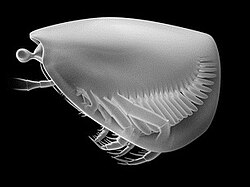
Back Thylacocephala German Thylacocephala Spanish Thylacocephala French Thylacocephala ID Thylacocephala Italian Thylacocephala Portuguese Thylacocephala Russian Thylacocephala Ukrainian 袋头纲 Chinese
| Thylacocephala | |
|---|---|

| |
| Restoration of Clausocaris, a Concavicarida | |

| |
| Reconstruction of Thylacares, once considered to be the earliest known thylacocephalan | |
| Scientific classification | |
| Domain: | Eukaryota |
| Kingdom: | Animalia |
| Phylum: | Arthropoda |
| Clade: | Mandibulata |
| Class: | †Thylacocephala Pinna et al., 1982 |
| Orders | |
| |
The Thylacocephala (from the Greek θύλακος or thylakos, meaning "pouch", and κεφαλή or cephalon meaning "head") are group of extinct probable mandibulate arthropods,[1] that have been considered by some researchers as having possible crustacean affinities. As a class they have a short research history, having been erected in the early 1980s.[2][3][4]
They typically possess a large, laterally flattened carapace that encompasses the entire body. The compound eyes tend to be large and bulbous, and occupy a frontal notch on the carapace. They possess three pairs of large raptorial limbs, and the abdomen bears a battery of small swimming limbs. Their size ranges from ~15 mm to potentially up to 250 mm.[5]
Inconclusive claims of thylacocephalans have been reported from the lower lower Cambrian (Zhenghecaris),[5] but later study considered that genus as radiodont or arthropod with uncertain systematic position.[6] The oldest unequivocal fossils are Upper Ordovician and Lower Silurian in age.[7][8] As a group, the Thylacocephala survived to the Santonian stage of the Upper Cretaceous, around 84 million years ago.[9][10]
Beyond this, there remains much uncertainty concerning fundamental aspects of the thylacocephalan anatomy, mode of life, and relationship to the Crustacea, with whom they have always been cautiously aligned.
- ^ Pulsipher, M. A.; Anderson, E. P.; Wright, L. S.; Kluessendorf, J.; Mikulic, D. G.; Schiffbauer, J. D. (2022). "Description of Acheronauta gen. nov., a possible mandibulate from the Silurian Waukesha Lagerstätte, Wisconsin, USA". Journal of Systematic Palaeontology. 20 (1). 2109216. doi:10.1080/14772019.2022.2109216. S2CID 252839113.
- ^ G. Pinna, P. Arduini, C. Pesarini & G. Teruzzi (1982). "Thylacocephala: una nuova classe di crostacei fossili". Atti della Società Italiana di Scienze Naturali e del Museocivico di Storia Naturale di Milano. 123: 469–482.
{{cite journal}}: CS1 maint: multiple names: authors list (link) - ^ S. Secrétan & B. Riou (1983). "Un groupe énigmatique de crustacés, ses représentants du Callovien de la Voulte−Sur−Rhône". Annales de Paléontologie. 69: 59–97.
- ^ D. E. G. Briggs, & W. D. I. Rolfe (1983). "New Concavicarida (new order: ?Crustacea) from the Upper Devonian of Gogo, Western Australia, and the palaeoecology and affinities of the group". Special Papers in Palaeontology. 30: 249–276.
- ^ a b Jean Vannier, Jun–Yuan Chen, Di–Ying Huang, Sylvain Charbonnier & Xiu–Qiang Wang (2006). "The Early Cambrian origin of thylacocephalan arthropods" (PDF). Acta Palaeontologica Polonica. 51 (2): 201–214.
{{cite journal}}: CS1 maint: multiple names: authors list (link) - ^ Pates, Stephen; Lerosey-Aubril, Rudy; Daley, Allison C.; Kier, Carlo; Bonino, Enrico; Ortega-Hernández, Javier (2021-01-19). "The diverse radiodont fauna from the Marjum Formation of Utah, USA (Cambrian: Drumian)". PeerJ. 9: e10509. doi:10.7717/peerj.10509. ISSN 2167-8359. PMC 7821760. PMID 33552709.
- ^ D. G. Mikulic, D. E. G. Briggs & J. Kluessendorf (1985). "A new exceptionally preserved biota from the Lower Silurian of Wisconsin, U.S.A.". Philosophical Transactions of the Royal Society. 311 (1148): 75–85. Bibcode:1985RSPTB.311...75M. doi:10.1098/rstb.1985.0140. JSTOR 2396972.
- ^ Van Roy, Peter; Rak, Štěpán; Budil, Petr; Fatka, Oldřich (2021-04-26). Jagt, John (ed.). "Upper Ordovician Thylacocephala (Euarthropoda, Eucrustacea) from Bohemia indicate early ecological differentiation". Papers in Palaeontology. 7 (3): 1727–1751. Bibcode:2021PPal....7.1727V. doi:10.1002/spp2.1363. hdl:1854/LU-8714218. ISSN 2056-2799. S2CID 235557325.
- ^ F. R. Schram, C. H. J. Hof & F. A. Steeman (1999). "Thylacocephala (Arthropoda: Crustacea?) from the Cretaceous of Lebanon and implications for Thylacocephalan systematics". Palaeontology. 42 (5): 769–797. Bibcode:1999Palgy..42..769S. doi:10.1111/1475-4983.00097.
- ^ The implications of a Silurian and other thylacocephalan crustaceans for the functional morphology and systematic affinities of the group